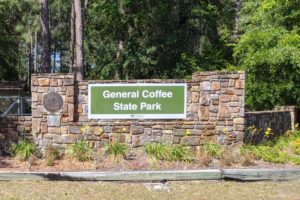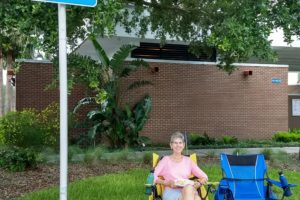As we left Lone Pine just a few miles north is Manzanar, the location of one of the 10 relocation centers built just after Pearl Harbor for Japanese-American citizens and Japanese immigrants. One of the reasons for this location was its proximity to a water source. The camp was built along this highway since enemy bombers couldn’t get here over the Sierras.

We had heard about these relocation centers but really hadn’t thought about them since we hadn’t come face-to-face with one. As we walked through the displays and buildings, we saw both sides of the issue.
For us, what we took from what you’re going to be seeing is this: how would we cope if our lives were uprooted and we didn’t have a choice in the matter? Would we stew in our emotions, or make lemonade out of the squashed lemons? How long would it take for us to transition from one phase to the next? And how about those who made the decisions that changed so many lives, and the friends and neighbors who were left in the neighborhoods and schools?
This center reminded us of the Jewish concentration camps also in WWII and the refugee camps today because people were taken from their homes and forced to live in different situations. So much to think about, but I guess that is what studying history should be all about.
what started the camps
Here’s a quote from the National Park Service brochure about the beginning of the camps. “For decades before World War II, politicians, newspapers, and labor leaders fueled anti-Asian sentiment in the western United States. Laws prevented immigrants from becoming citizens or owning land. Immigrants’ children were born US citizens, yet they too faced prejudice. Japan’s December 7, 1941 attack on Pearl Harbor intensified hostilities toward people of Japanese ancestry. [Also, a Japanese submarine was sighted along the coast near Los Angeles, which fueled the fears.]
“President Franklin D. Roosevelt signed Executive Order 9066 on February 19, 1942, authorizing the military to remove ‘any or all persons’ from the West Coast [California, Oregon, and Washington]. The Army applied the order to everyone of Japanese ancestry.
“They were from cities and farms, young and old, rich and poor. They had only days or weeks to prepare. Businesses closed, classrooms emptied, families and friends separated. Ultimately, the government deprived over 120,000 people of their freedom. Half were children and young adults. Ten thousand were incarcerated at Manzanar.”
So the Army quickly had to find suitable locations and build these camps. They built as they did for soldiers because this is what they knew. In the spring of 1942, the abandoned town site of Manzanar, California, just north of Lone Pine, was turned into one of these camps to confine 10,000 Japanese citizens and immigrants.
One of the reasons this area was chosen was because of the availability of water from Shepherd Creek just north of the site that flows year-round and is fed by melting snows in the Sierras. The Army soon realized that this water source wouldn’t support the need, so they built a reservoir nearby. This water source was used wisely by the men and women as they made this center their home for a few years.
relocation centers



We did read that Highway 395, the road we’re driving north on, was the main thoroughfare for the Army since they knew that transports couldn’t be attacked by the Japanese since they wouldn’t be able to get over the Sierras.
barracks
The center was set up quickly and orderly, but the speed meant the that only the basics were provided.



barracks – year 1

if a family was smaller than 8, another family would be joining them.


barracks – a few months later
By the middle of the summer in 1942, life started getting a little better. By year 2, the families built furniture and made their living areas more hospitable for themselves.





After getting a post office soon after they arrived, neighbors from home were able to send possessions, Sears Roebuck did a great business, and local people helped out.



Here are some more examples of furniture that was made, primarily out of fruit crates! So beautiful.



what about the children?
As said previously, more than half of the population were children and young adults. No provision for education had been made ahead of time since the moves were done so quickly, but learning was quickly set up by local teachers helping out and older children who helped out with the younger ones.

It seems as though so many of the young moms were in shock over the relocation that they weren’t able to care for their children, and the barracks were no place for the young children to play and take naps. So nurseries and preschools were set up.



Classes for the young children were set up and furniture made just for them.


Since the children weren’t able to bring toys with them since only what could be carried was brought, these toy loan centers were set up so children could check out toys like library books.


Older students also had their classroom in each barracks grouping.


Education an important part of community life.





self-governing



Sports and community life







gardens



employment and supporting the war effort


high school activities

mess hall



in line to sign up for classes and get food. Something we all get
to learn in life, I think.

mothers of infants




food prep










latrines

I think this was a large part of the problem for the women since they had no privacy that they were used to. One of the comments in the displays was that some women would wait until everyone was asleep to use the latrines, and then they’d go to a different block so they wouldn’t see women they knew.


but not at all welcoming for these women
comments by those in the relocation center



some went into the Army




when they could so life could go on
In the 1980s, President Reagan led the effort to send letters of apology to those still living as well as individual payments of $20,000 each in order of age, from oldest to youngest, between 1990 and 1999. One woman said after receiving her apology letter from President George H.W. Bush, “felt as though the shame of all these years has been lifted and I was able to talk about the experience with much more ease. This letter of apology has meant a great deal to me, more than anyone can imagine.”
Since these relocation centers were established just because of ancestry, Martin Luther King, Jr.’s words mean so much more.





